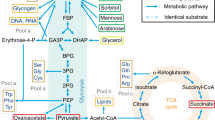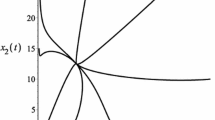Abstract
Simultaneous limitation of microbial growth by two or more nutrients is discussed for dual carbon/nitrogen-limited growth in continuous culture. The boundaries of the zone where double-limited growth occurs can be clearly defined from both cultivation data and cellular composition and they can be also predicted from growth yield data measured under single-substrate-limited conditions. It is demonstrated that for the two nutrients carbon and nitrogen the zone of double nutrient limitation is dependent on both the C:N ratio of the growth medium and the growth (dilution) rate. The concept on double-(carbon/nitrogen)-limited growth presented here can be extended to other binary and multiple combinations of nutrients.
Similar content being viewed by others
References
Aiking H & Tempest DW (1977) Rubidium as a probe for function and transport of potassium in the yeast Candida utilis NCYC 321, grown in chemostat culture. Arch. Microbiol. 115: 215–221
Al-Awadhi N, Egli T, Hamer G & Mason CA (1990) The process utility of thermotolerant methylotrophic bacteria: I. An evaluation in chemostat culture. Biotechnol. Bioeng. 36: 816–820
Baltzis BC & Fredrickson AG (1988) Limitation of growth rate by two complementary nutrients: some elementary but neglected considerations. Biotechnol. Bioeng. 31: 75–86
Cooney C, Wang DIC & Mateles RI (1976) Growth of Enterobacter aerogenes in a chemostat with double nutrient limications. Appl. Environ. Microbiol. 31: 91–98
Duchars MG & Attwood MM (1989) The influence of the carbon: nitrogen ratio of the growth medium on the cellular composition and regulation of enzyme activity in Hyphomicrobioum X. J. Gen. Microbiol. 135: 787–793
Egli T (1982) Regulation of protein synthesis in methylotrophic yeasts: repression of methanol dissimilating enzymes by nitrogen limitation. Arch. Microbiol. 131: 95–101
Egli T & Quayle JR (1984) Influence of the carbon: nitrogen ratio on the utilization of mixed carbon substrates by the methylotrophic yeast Hansenula polymorpha. Proceedings of the 100th Annual Meeting of the Society for General Microbiology, Warwick (p M13)
(1986) Influence of the carbon: nitrogen ratio of the growth medium on the cellular composition and the ability of the methylotrophic yeast Hansenula polymorpha to utilize mixed carbon sources. J. Gen. Microbiol. 132: 1779–1788
Egli T & Schmidt CR (1990) Dual-nutrient-limited growth of microbes, with special reference to carbon and nitrogen substrates. In: Hamer G, Egli T & Snozzi M (Eds) Mixed and Multiple Substrates and Feedstocks (pp 165–167). Hartung-Gorre, Constance
Egli T, Bosshard C & Hamer G (1986) Simultaneous utilization of methanol-glucose mixtures by Hansenula polymorpha in chemostat: influence of dilution rate and mixture composition on utilization pattern. Biotechnol. Bioeng. 28: 1735–1741
Gräzer-Lampert SD, Egli T & Hamer G (1986) Growth of Hyphomicrobium ZV620 in the chemostat: regulation of NH sup+inf4 -assimilating enzymes and cellular composition. J. Gen. Microbiol. 132: 3337–3347
Hamer G, Harrison DEF, Harwood JH, Topiwala HH (1975) SCP production from methane. In: Tannenbaum SR & Wang DI (Eds) Single Cell Protein II (pp 357–269). MIT Press, Cambridge, Mass.
Harder W & Dijkhuizen L (1976) Mixed substrate utilization. In: Dean ACR, Ellwood DC, Evans GGT, Melling J (Eds) Continuous Culture 6: Applications and New Fields (pp 297–314). Ellis Horwood, Chichester
(1982) Strategies of mixed substrate utilization in microorganisms. Phil. Trans. R. Soc. Lond. B 297: 459–480
Harrison DEF (1972) Physiological effects of dissolved oxygen tension and redox potential on growing populations of microorganisms. J. Appl. Chem. Biotechnol. 22: 417–440
Herbert D (1976) Stoicheiometric aspects of microbial growth. In: Dean ACR, Ellwood DC, Evans CGT & Melling J (Eds) Continuous Culture 6. Applications and New Fields (pp 1–30). Ellis Horwood, Chichester
Hueting S & Tempest DW (1979) Influence of the glucose input concentration on the kinetics of metabolite production by Klebsiella aerogenes NCTC 418: growing in chemostat culture in potassium- or ammonia-limited environments. Arch. Microbiol. 123: 189–199
von Liebig J (1840) Organic Chemistry in its Application to Agriculture and Physiology English translation by L. Play-fair]. Taylor and Walton, London
Linton JD & Stephenson RJ (1978) A preliminary study on growth-yields in relation to the carbon and energy-content of various organic growth substrates. FEMS Microbiol. Lett. 3: 95–98
Minkevich IG, Krynitskaya AY & Eroshin VK (1988) A double substrate limitation zone of continuous microbial growth. In: Kyslik P, Dawes EA, Krumphanzl V & Novak M (Eds) Continuous Culture (pp 171–189). Academic Press, London
Monod J (1942) La croissance des cultures bactériennes. Hermann, Paris
Moriarty DJW (1986) Measurement of bacterial growth rates in aquatic systems from rates of nucleic acid synthesis. Adv. Microb. Ecol. 9: 245–292
Pearl HP (1977) Factors limiting productivity of freshwater ecosystems. Adv. Microb. Ecol. 6: 75–110
Robertson LA & Kuenen JG (1990) Mixed terminal electron acceptors (oxygen and nitrate). In: Hamer G, Egli T & Snozzi M (Eds) Mixed and Multiple Substrates and Fecdstocks (pp 97–106). Hartung-Gorre, Constance
Rutgers M, Balk PA & van Dam K (1990). Quantification of multiple-substrate controlled growth. Simultaneous ammonium and glucose limitation in chemostat cultures of Klebsiella pneumoniae. Arch. Microbiol. 153: 478–483
Stephenson M (1949) Growth and nutrition. In: Bacterial Metabolism, 3rd ed (pp 159–178). Longmans, Green & Co., London
Strange RE & Hunter JR (1967) Effect of magnesium on the survival of bacteria in aqueous suspension. In: Powell EO, Evans CGT, Strange RE & Tempest DW (Eds) Microbial Physiology and Continuous Culture (pp 102–123). H.M.S.O., London
Tempest DW, Herbert D & Philipps PJ (1967) Studies on the growth of Aerobacter aerogenes at low dilution rates in a chemostat. In: Powell EO, Evans CGT, Strange RE & Tempest DW (Eds) Microbial Physiology and Continuous Culture (pp 240–257). H.M.S.O., London
Tempest DW & Dicks JW (1967) Interrelationships between potassium, magnesium, phosphorus and ribonucleic acid in the growth of Aerobacter aerogenes in a chemostat. In: Powell EO, Evans CGT, Strange RE & Tempest DW (Eds) Microbial Physiology and Continuous Culture (pp 140–145). H.M.S.O., London
Tempest DW & Neijssel OM (1978) Eco-physiological aspects of microbial growth in aerobic nutrient-limited environments. Adv. Microb. Ecol. 2: 105–153
Veldkamp H & Jannasch HW (1972) Mixed culture studies with the chemostat. J. App. Chem. Biotechnol. 22: 105–123
Wanner U & Egli T (1990) Dynamics of microbial growth and cell composition in batch culture. FEMS Microbiol. Rev. 75: 19–44
Author information
Authors and Affiliations
Rights and permissions
About this article
Cite this article
Egli, T. On multiple-nutrient-limited growth of microorganisms, with special reference to dual limitation by carbon and nitrogen substrates. Antonie van Leeuwenhoek 60, 225–234 (1991). https://doi.org/10.1007/BF00430367
Issue Date:
DOI: https://doi.org/10.1007/BF00430367




